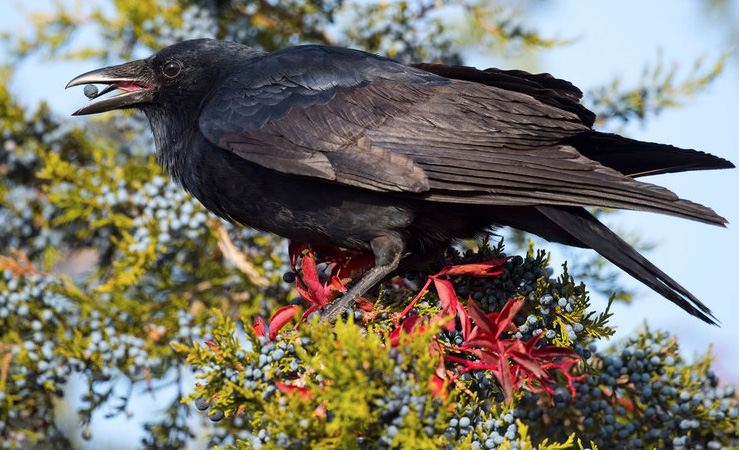At home in cities, suburbs and rural farmlands, crows seem to be everywhere.
One of Kentucky’s most abundant bird species, they make their presence known with a raucous call: “CaaW, CaaW, CaaW.”
They are smart, alert, and social birds.
There are two species of crows in Kentucky.
American crow
The species found throughout Kentucky is the American Crow (Corvus brachyrhynchos).
The Americans Crow is a member of the Jay Family Corvidae, first identified in the scientific literature by German ornithologist Christian Ludwig Brehm in 1822.
Kentucky’s other species of crow is far less visible.
The Fish Crow (Corvus ossifragus) makes its home in the far western reaches of the Purchase Region, in wetlands, creeks and sloughs along the Mississippi River and its tributaries. The two species are almost identical, but the fish crow is smaller and has a more subdued call.
Size and coloration
From beak to tail, an American Cow measures about 16 to 20 inches. They have long tails and a wingspan of about 33 to 39 inches.
They typically weigh 11 to 21 ounces, with males tending to be larger than females. Plumage is all black, with iridescent feathers, pointed at their wingtips.
Range and distribution
The American Crow is present year-round in all of the Lower 48 states, but they are absent or there are lower populations in parts of five states in the arid southwest.
They nest in parts of six Canadian Provinces, departing southward when cold weather arrives.
In Kentucky, the American Crow is present in all 120 counties, with lower populations in the heavily-wooded Cumberland Mountains.
Crow populations in Kentucky are stable, but do fluctuate seasonally.
Local populations usually begin to swell in the fall as migrants from the north arrive, and family groups intermingle, forming large communal roosts.
Their susceptibility to the West Nile virus caused some populations to dip in the early 2000s, but they rebounded.
Habitat
The American Crow lives in a wide variety of semi-open habitats, including woodlands, farms, fields, river shores, small towns and even larger cities, often nesting in city parks. Deserts and other hot arid zones are avoided.
Food habits
They rarely travel alone and usually feed on the ground, eating earthworms and grubs in freshly plowed fields, insects, wheat and corn seeds in farm fields, and fruit. Crows will also eat carrion (road kill), and the chicks of other birds they rob from nests.
In town, they are just as likely to be eating scraps of fast food on a mall parking lot or garbage along roadways. Crows are best described as omnivorous foragers.
Countship and nesting
In courtship on the ground or in tree, the male faces female, fluffs up body feathers, partly spreads wings and tail, and bows repeatedly while giving a short rattling song.
Mated pairs perch close together, touching bills and preening each other’s feathers.
Their nest site is in tree or large shrub, 10 to 70 feet above the ground, usually in vertical fork or at the base of branch against the tree trunk. Built by both sexes, the nest is a large bulky basket of sticks, twigs, bark strips, weeds, and mud, lined with softer material such as grass, moss, plant fibers, or feathers.
The female typically lays four to six dull blue-green to gray-green eggs, blotched with brown and gray. Incubation by the female is about 18 days. The young are fed by both parents and sometimes assisted by a “helper,” an offspring from a previous season. Young leave the nest about four to five weeks after hatching.
Whether you admire them or despise them as a nuisance, crows are here to stay, visible just about anywhere from city parks to rural roadsides, walking on the ground, perched in fencerows or sailing through the skies.






